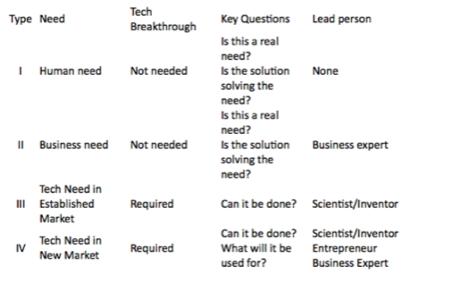
Guest author Gal Nachum is an entrepreneur, 5X founder and startup mentor.
There’s more than one way to skin a cat, and there are many ways to classify a startup. For a classification framework to be useful, it needs to be more than just informative. It should help us understand the essence of the startup and guide us in how to qualify and quantify its potential.
Common classification methods—such as classifying startups by the domain in which they operate (for instance, cyber security or healthcare), its target customers (B2C or B2B) or its technical domain (hardware or software)—are quite informative. Unfortunately, they provide little guidance about how to assess a startup. In doing so, consider the following instead.
A Startup Is A Need, Plus Solution
A startup is usually a combination of two things: an interesting problem or need, and an approach for solving that problem. It is easy to come up with big and worthy problems, but they tend to go beyond the scope of the typical entrepreneur. (If you have a solution for eternal peace or even just for unlimited clean energy, give me a call. I’m sure we can work something out.)
The challenge, then, is not just to find a worthy problem, but to also find an approach for solving it. Sometimes the problem is evident, but the solution is elusive. Many times, it is the problem itself that is hard to pinpoint, and once it is clearly defined and understood, how to solve it becomes evident.
We are looking for a problem-solution combination. We can glean insight by looking at different types of problems, various sorts of solutions and the relationships between them.
There are three primary types of problems or needs: a human need, a business need and a technical need.
A human need is anything that we, as human beings, perceive as valuable. Most consumer ventures are addressing a human need. Facebook, Apple and Netflix are some examples of well-known ventures doing just that.
A business need is anything that would help an organization, usually a company, to perform better in some sense. Most B2B (business to business) startups fall under this category. IBM, Salesforce and Slack are some examples of well known companies serving business needs.
A technical need is the need for some system or component to perform better. For almost any system or component, there is a need for it to perform better in some sense, or for it to be less expensive. This need is ubiquitous. When Intel develops a CPU with a faster clock speed, or with lower power consumption, it is addressing a technical need. While it is true that a technical need will ultimately serve some business or human need, its characteristics are different, so we’ll consider it a separate category.
When looking at solutions there are two main categories worth discussing: a technical breakthrough and a solution that requires solid engineering, but not a major technical breakthrough.
A technical breakthrough is a capability that did not exist before—perhaps something you can do and no one else can. That could be a new encryption algorithm that’s harder to break or easier to use, a battery with a higher energy density and a car engine that does twice the mileage. It can either take place in an established market or in a new market.
A technical breakthrough may mean that you can produce a superior version of a product for which there’s already an established market—like developing a cell phone battery with twice the energy capacity, for example. You could make a spaceship that can fly to Mars, and that would certainly be a technical breakthrough. But interstellar spaceships are currently not an established market.
Four Startup Templates
Based on the above classification we can now look at some common templates for startups based on the needs and solutions they represent.
Human needs and business needs seldom require a technical breakthrough. Solid engineering is usually sufficient. There are two key questions which must be answered for these kinds of startups: Is this really a need, and is the proposed solution really solving it?
Those are questions for the domain expert. For a business need, the domain expert is a person who knows this industry in and out. For a human need the situation is trickier as there is no real equivalent to the business domain expert. Common wisdom nowadays is that the only way to answer our key questions is to measure how the market responds to our solution using data analytics techniques.
The key questions for a tech need in an established market are very different. As this is an established market there is no real question about the need. The only question is whether it can be done. This solution will most probably be of the technical breakthrough category. The person to answer the key questions this time is the researcher or scientist who invented the breakthrough or designed the solution.
The case of a technical breakthrough in a new market is probably the most challenging one. Here we need to ask not only whether it can be done but also what will be done with it. While the feasibility aspect should obviously get addressed by the inventor of the technical breakthrough, the business aspect is less clear. We cannot employ a business expert as the business domain is not determined yet. In this case a business innovator with an entrepreneurial vision is needed in order to envision the potential of the invention and its possible uses. A business expert can then validate specific uses of the invention, once they are defined.
This can be summarized in the following table:

Granted, this is a crude classification, and it has some overlaps. A technological breakthrough can serve a need in an established market, and at the same time have other implementations in new markets. This classification is nevertheless useful in helping identify the key questions we should ask about a startup, and what kind of people should be trusted to provide the answers.
So, if you want to start a type II startup, which includes most B2B startups, you need have a business expert on hand. For the tech need category, a scientist is always a must. The type IV startup is a very challenging case, as it requires multiple lead people. It is also the kind of startup that may have a far-reaching potential.
The type I startup, which includes most consumer startups, is unique; there’s no lead person and no need for a technical breakthrough. This combination may explain both the vast amount of consumer startups we’ve seen in recent years, and the much lower success rates compared to the other startup categories.
Photo by Epic Bets










